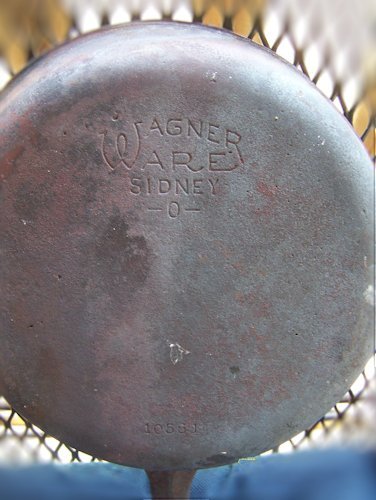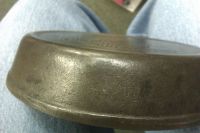Damage & Defects
You may have seen books on cast iron collecting which give suggested values of various pieces. It's important to note that such values are only applicable to pieces "in excellent condition". Collectible vintage cast iron cookware is not regarded as having intrinsic value. That is to say, for example, a rare Griswold #2 large block logo, heat ringed skillet in perfect condition may be considered to be worth several hundreds of dollars. Not so, however, if it is warped, cracked, pitted, or otherwise damaged. Just because it is what it is does not determine its collectible value.
While changing market conditions over the years may affect prevailing prices, collectors continually strive to obtain the best examples of pieces as free as possible from unreasonable damage or material defects that they can. The following addresses what you should look for when assessing the value of collectible cast iron.
Damage
Many people think cast iron is indestructible. It is not. While the build-up of time and the ravages of neglect, in the form of carbon and rust respectively, can be easily cleaned from it, cast iron is in many ways fragile and must be handled with care and respect. Similar to the properties of glass, cast iron is strong but brittle; it will break before it bends.
There are several ways a piece of cast iron cookware can be damaged, as noted above: chipping, cracking, warping, and pitting. The first two can be caused by physical impact; the second two by improper rapid heating or cooling, also known as thermal shock. Pitting, the result of the chemical erosion of metal, we'll cover in just a minute.
Ironically, chipping and cracking are the least problematic, in that they are only cosmetic-- the pan can still be used without much difficulty. Heat cracks are usually hairline, occuring most often in the sidewall of a pan, and typically either don't leak, or are quickly sealed by seasoning. Collectible value, however, is drastically reduced.
Spotting a chip is usually easy, as they occur primarily on the lip of a pan, or, if the pan has one, the heat ring. Sometimes, what appears to be a chip is actually a void in the casting caused by an air bubble trapped in the iron as it cooled and hardened.
Cracks are often harder if not impossible to detect, unless the pan has been stripped of all built-up seasoning. Even on bare metal, a heat crack is often dismissed as a utensil scratch. Holding the pan at an angle to a bright light source, check any vertical scratches on the sidewall of a pan for a counterpart on the opposite side, noting if it also crosses the rim of the pan. If so, you've got a cracked pan.
There is a saying that you can verify a pan is not cracked if it "rings like a bell when tapped with a wooden spoon". But the quality of the tone produced is often subjective, and not a guarantee. A build up of seasoning may muffle the ringing sound of a well-used but otherwise intact pan, and it may also obscure hairline cracks. A thicker, heavier pan may also have a more dull sound than that of a thinner, lighter pan.
Warping can be troublesome. An empty pan placed and left on a burner set on high heat for a very short time can result in warping. With nothing in the pan to absorb and distribute the heat, metal in one spot in the bottom of the pan expands more rapidly than the surrounding area, and what was once smooth and flat ends up irreversibly concave or convex. Rapid cooling, such as dropping a hot pan into a sink full of water, can cause similar damage. The result when trying to use a warped pan is uneven cooking, as liquids and cooking fats now pool in the middle of the warp or are dispersed to the edges of the pan away from it, depending on the direction. Some modern kitchen stoves have also introduced an additional problem using warped cast iron: it doesn't make the necessary flush contact with smooth glass cooktop burners, rendering it all-but-useless on them. A slightly warped pan may still be usable on a gas stove burner or in the oven, but its collectible value is also greatly diminished.
I created a short video with my smartphone to demonstrate how to easily detect a downward-bowed pan warp. On a hard, level surface, such as the polished stone tile in the video, the pan will rock or "wobble", as collectors like to say. By pressing on the rim of the pan at various points, you can feel and see the movement, and listen for the clicking sounds that are tell-tale signs of warping. At the end of the video, you can also see why collectors call such pans "spinners". Note that an upward-bowed pan can still "sit flat" on its perimeter, so checking the surface inside with a straightedge may also be necessary.
Additionally, cosmetic damage can be caused by allowing rust to go unchecked to the point of pitting the metal. Once any significant amount of metal is lost to rust, it cannot be repaired, although, with time and effort, rust pitting in cooking surfaces may be filled in with accumulated layers of new seasoning.
On the bottoms of older pans, you may also see eroded metal that might be mistaken for rust pitting. What you're actually seeing is an acid erosion. Coal, as did natural gas supplies many years ago, contains sulfur as an impurity, which results in the formation of sulfuric acid upon burning. Continual use over a sulfur-laden heat source would over time result in metal actually being dissolved and displaced. As a consequence, finding older pans with no evidence of sulfur pitting is often difficult.
Both forms of metal pitting result in diminished collectible value.
There's another form of damage which results, unfortunately, from good but misguided intentions. You'll often hear or read how simple cast iron cleaning can be if you just burn a pan in a fire. If the fire burns too hot, however, the molecular structure of the iron can be irreparably changed. Iron so-damaged will have an often scaly, patchy, dull red appearance, different from regular rust's orange/brown. Re-seasoning over such damage is usually not possible. A fire-damaged pan:

Finally, there is one last form of damage to consider, that of contamination. This is especially of concern if the pan is to be used for cooking. For pans left out in uncontrolled environments, artifacts of rodent nesting are of concern, but while distasteful, should be alleviated by the methods used to remove cooking build-up.
The more important concern as regards contamination is that of heavy metals. Although infrequently seen, cast iron pans have been known to be used for melting lead, typically for fishing weights or the like. This type of contamination is undeniably of concern, and pans obviously used for it should clearly be left out of the kitchen cupboard. This is not to say every pan should be held suspect, but, if a metallic residue is observed, test kits such as those sold in hardware stores to detect lead in paint can be used for confirmation.
Defects
Although the major foundries produced high quality products, there are sometimes seen instances where defects slipped through the controls. At the time, some common minor defects may have been of no concern to either manufacturer or consumer. Cast iron ware, being considered a rather utilitarian commodity, was commonly shipped in bulk, packed in sawdust in wooden barrels.
Most often seen, and usually mistaken for utensil marks, are pinpoint casting voids. A void is what occurs when the molten iron solidifies without having completely filled the mold cavity. It's like a trapped air bubble. Voids on the cooking surface, if tiny and not numerous, are usually not of concern to the average collector; they will quickly fill with seasoning, and affect neither cooking nor displayability.
More distracting can be a sag. If a part of the sand mold shifted between the time the pattern was removed and the iron was poured, the result would be cast into the molded piece. Sags look like wavy, uneven lines across the surface of the piece. While they don't normally affect usage, their appearance does detract from collectible value.
Wavy lines can also be the result of what's known as a "cold pour". Typically, a foundryman would transfer a ladle from the furnace to the molding area containing enough molten metal to cast several pans at a time. If there was a delay or the molder did not move quickly enough, the metal would begin to cool, impeding it from flowing properly inside the mold of the last of the pans cast. Sometimes, the imperfection would be deemed negligible and not worthy of rejection.
Occasionally, you'll also see characters or other markings that appear shallow or missing altogether. Bear in mind that incised markings on the molded piece would be made by raised areas on the inside surface of the sand mold cavity. If a raised area happened to break off when the pattern was removed, the markings it should have made in the pan would not occur.
Rarely, you will see a piece which appears to have a piece of a foreign object embedded in the iron. This is known as a slag inclusion, and can consist of another metal, or a bit of refractory material from the furnace or the ladle which transferred molten iron to the casting area.
Non-Defects
There are a couple of things that you'll regularly see on a cast iron pan that you might mistake for damage or defect. Finish grind marks and flashing are both common, and should not be considered as negatives.
Nearly every cast iron cookware piece produced by the technology of the late 19th century and after will have grinding marks at various points along the outside lip. Under earlier casting technology, the iron entered the mold at what would become the bottom of the pan. With the advent of the woodstove, flat-bottomed pans became necessary, requiring a rethinking of the molding technique. The answer lay in having the iron enter the mold cavity at what would become the outer top edge of the piece, and that's from where the excess iron from the casting process is trimmed. A final pass of the edge across a grinding wheel smoothed any remaining roughness, but leaving a narrow band of striated vertical marks.
Flashing is what occurs when the halves of a sand mold do not come together as precisely as they should. When the iron is poured, some seeps into the tiny crack between the halves, leaving a thin fin or web of metal protruding from the edge of the piece. Most is trimmed off as a part of the finishing process, but some is often seen remaining inside the hanging hole of a pan handle. Most people leave it alone, as it doesn't affect cooking or handling. As long as part of the actual casting is not damaged, the careful trimming or filing off of flashing does not seem to affect collectible value one way or the other.
You'll occasionally see on the bottom of some pieces what appears to be the head of a screw. This is not a repair of a defect, but rather a quality control measure some foundries used after the advent of automation. If a pattern became suspect of causing defective pieces, it would be marked so the pans made from it could be easily identified. A simple method of marking involved driving a screw into the pattern. A curiosity at most, and collectible value is not affected.
Older cast iron lid handles will often have what looks like a crack at their apex. It's not a crack, but rather the point at which the two hinged, retractable parts of the pattern which formed the handle met. Often the joint is tight enough to be nearly imperceptible; sometimes not.
Alterations
There are a few other artifacts of the manufacture of cast iron you'll see from time to time, relating to the processes of pattern-making and molding, that are not necessarily considered damage or defects.
When a change to trademarks or other markings occurred, it was common to alter existing patterns, in order to avoid the expense, time, and trouble of creating entirely new patterns.
One method of pattern alteration involved the creation of a replacement area on a separate thin piece of pattern material. The area containing the obsolete markings would be excised from the existing pattern, and the new piece affixed in its place. If the depth of the area removed did not exactly match the thickness of the replacement piece, its border would be apparent in the resulting castings. Examples of this are often seen on pieces from both Favorite and Chicago Hardware Foundry.
If an area of markings on a piece was to be removed altogether and not replaced, a filler material would simply be applied to the unwanted markings on the pattern, preventing them from being transferred to subsequent molds. If the material was not precisely smoothed to match the surrounding surface on the pattern, the result would show on the casting as an area that appears "smeared". This practice and the manifestation of it on a cast iron piece is sometimes referred to as "buttering". While not a defect per se, such pieces are somewhat less desirable as collectibles, the possible exception being when it involved covering the markings of a competitor to make a pattern from their pan.









